Wasp Control and Removal Service
PROFESSIONAL and GUARANTEED
Wasp control SOLUTIONS BY
THE EXTERMINATORS INC.
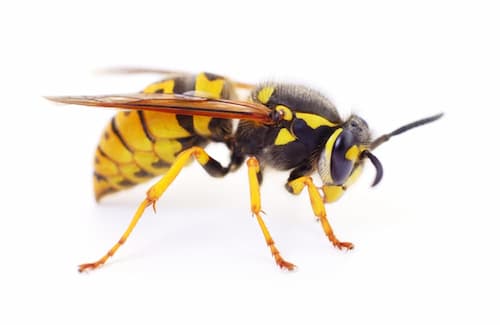
Guaranteed Service
WE TAKE PRIDE IN OUR WORK AND SEE EVERY JOB THROUGH. IF WASPS RETURN WITHIN THE CONTRACTUAL PERIOD SO WILL WE.
If contractual pests return following service and within the guarantee and warranty period we will return them at no additional cost. We work hard on keeping our customer’s wasps free. We guarantee every service and provide extensive warranties to make sure wasps are gone and our customers are happy. Call Wasp Control – The Exterminators Inc. for professional wasp nest removal.

Wasp removal solutions by licensed AND INSURED exterminators
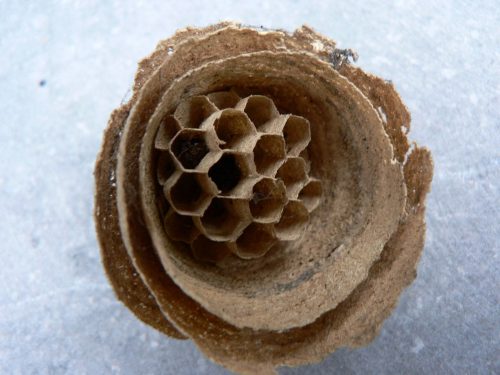
Our wasp removal services will provide you with trained technicians who know how to safely remove these nests as well as exterminate the hornets and wasps in them. Since these dangerous insects attack in swarms if their nests are disturbed, our technicians take every obligatory precaution to ensure your complete safety.
Mississauga
Guaranteed wasp nest removal solutions in Mississauga by licensed exterminators. We remove the wasp nest and take the necessary steps to make sure the wasps won’t come back.
Burlington
Any time you think of fighting wasps, remember that this can turn out to be a dangerous process especially if you are allergic to stings. Contact Was Control at Brampton and we will provide you with professional services.
Etobicoke
Wasp and Hornet Removal Etobicoke. Effective reliable treatments. Professional exterminators remove wasps and hornets. Don’t risk the removal on your own. Have a trained professional perform the work needed to get rid of the problem.
Markham
Effective treatments in Markham. We get rid of the nest so you don’t have to risk getting stung. Wasps are dangerous. Licensed exterminators with the know-how and the proper gear to get rid of the problem.
Wasps belong to the order Hymenoptera and share the same insect family such as ants and bees, although their behavioral patterns set them apart from both these species to a great degree. While some wasps are even solitary, the ones that are social and cause us nuisance during those warm summer months are the ones that are usually a cause for concern.
Apart from causing a ruckus by invading our space, wasps are also capable of nasty stings, the results of which could even be fatal in the presence of allergies and other complications.
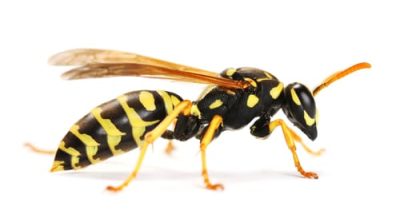
Wasp Control
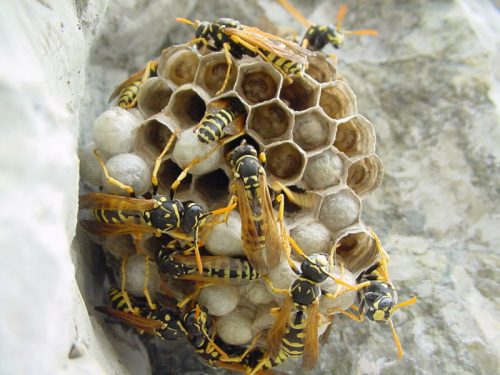
Call us today and our licensed and trained professionals will soon be at your doorstep with a guaranteed solution.
CALL FOR A FREE ESTIMATE
Types of Wasps
In North American regions, Yellowjackets, Baldfaced Hornets and Paper Wasps are the most common wasps. Yellowjackets range from 3/8 to 5/8 inch in size and are usually a bright yellow with black lines running along their abdomen. In some species, you can even find spots or triangles as well as diamond-shaped designs on their bodies. Due to their color as well as design, they are often mistaken for bees. Baldfaced hornets are slightly larger, about 7/8 inch in size with white or cream-colored markings on their heads as well as towards the end of their abdomens. Paper wasps are slender creatures and their sizes range between ½ an inch to even an inch. These wasps are brown in color with yellow markings on their bodies.
Wasps feed on a wide variety of insects including spiders and even feed on rotting meat etc. They prefer these items in their diet, although they are occasionally known to feed on the nectar of flowers and ripened or overripe fruits. Around human habitat, wasps are often attracted to the garbage lying around homes or just about anything else they might find easily.
Bald-Faced Hornets
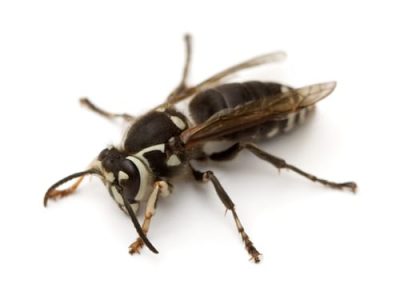
Bald-Faced Hornets can be generally recognized by their black body and their white face. Bald-faced hornets are typically larger than their paper wasps counterparts where they can reach 15mm to 20mm. Most of their activity happens at day time and they look usually , overhands, and soffits to build their nests with. The colony usually starts out in spring when a queen places an egg in each cell as she begins to build her nest. The size of a bald-faced nest can reach the size of a soccer ball in just a span of a few months. During winter, males and workers usually die off while the fertilized females survive the winter and go into hibernation.
YellowJacket Wasps
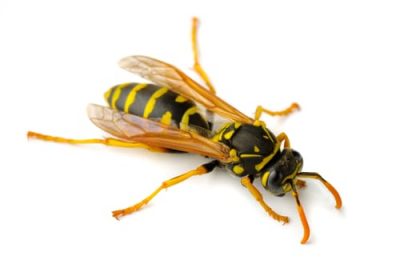
Yellowjackets have a bold yellow and black color pattern. The yellow is bright, and the black often forms distinct stripes on the abdomen. They have a slender, elongated body with a distinct waist. They are known to be aggressive defense of their nests. If they perceive a threat, they can become highly defensive and may sting multiple times. They are the most common type of wasp we deal with.
Mud Daubers
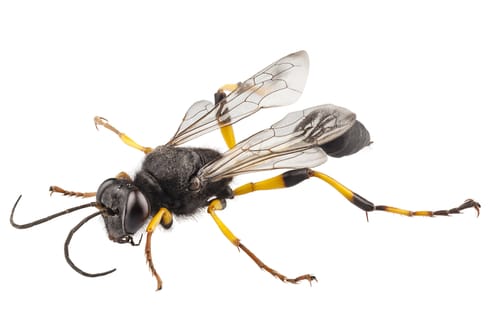
Mud Daubers are unique in the sense that they make their nests out of a combination of mud and salvia. When the nest reaches its completion, it goes around looking for spiders to feed its young with which he puts in the cylindrical cone shaped nests. The meds-dauber steadily creates the nest from the mud and fashions it into its shape in the span of a few days to a few weeks. When the mud dauber, as previously mentioned, leaves a meal, the mud dauber is still in its egg. When it hatches the mud dauber has the needed protein to kick of its developmental stages.
Carpenter Bees
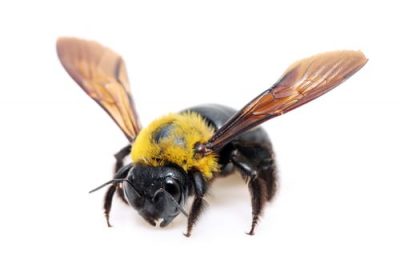
Carpenter bees look like honey bees. The distinguishing factor in carpenter bees is that they dig their nests from wood by vibrating their bodies creating a hole that measures 16 mm in diameter. They carve out tubes in the wood not covered in bark and generally soft woods. Their mates feed on pollen while they themselves feed on various bugs. Male carpenter ants are only able to show aggression in contrast to the females who are actually able to inflict the damage.
CALL FOR A FREE ESTIMATE
Wasp Nesting Habits
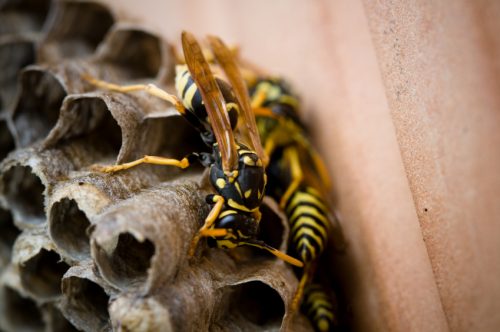
As far as nesting is concerned, yellowjackets and baldfaced hornets both build their nests from a papery pulp that they make with a mix of their saliva and wooden fibres they chew on. Yellowjackets prefer hollow spaces to build their nests in and are even known to build them underground. Paper wasps prefer horizontal surfaces and you can often find their nests hanging from beams and other such spaces. All three species of wasps do not have the habit of occupying the same nests when the next season comes along.
Therefore, if you are hunting down a wasp nest and do not find one in plain view, chances are that they are hidden in a variety of places from inside hollow logs, burrows under the ground, in nooks and crannies in buildings and cavities in walls, compost piles, trees, attics or just about anywhere else.
Nests that thrive in numbers can even have thousands of wasps in a single colony, thereby causing a considerable amount of nuisance when in close proximity to human habitat. Moreover, the risk of stings increases with these numbers too. In fact, while it is a general notion that wasps do not attack unless provoked, some yellowjackets have been found to be extremely aggressive during late summer and even sting without provocation.
While wasp stings usually only cause local reactions like burning, itching, pain, or swelling that could sometimes last until a week, it is the allergic reactions that some people might have that are a cause for alarm. Respiratory complications, swellings in places away from the sting, headaches and hives or rashes are common symptoms in the event of an allergic reaction. However, on rare occasions, the person may even go into Anaphylactic Shock, a condition, which if left untreated, could even prove to be fatal.

Wasp Removal and Control
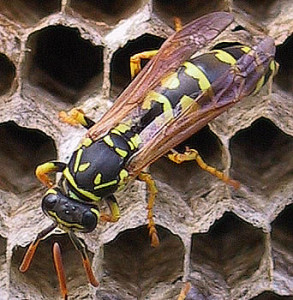
At Wasp Control, we understand the risks associated with wasps as well as know just how much a nuisance they can be even when they are not attacking. At the same time, we also know just how risky it is to attempt to remove a wasp’s nests without the right equipment and protective clothing. It may seem like an easy task, especially if the nest is small in size, but when even a single wasp can cause a whole lot of complications, you can only imagine what even a few dozens of these pests can do.
On our team, we have trained and licensed technicians who are extremely efficient at what they do. Our technician will first visit your home or office, run a thorough inspection of the premises, zero in on the possible locations of the wasp nest or nests, gauge their size and risks involved, and then give you a detailed description of the process that will be out to work to get rid of these nests as well as the wasps in the vicinity. After carrying out the removal, we will also leave you with plenty of tips on how you can avoid wasp infestations in the future.
Call Wasp Removal today on 647-360-6809 for a permanent solution to your wasp invasion troubles!